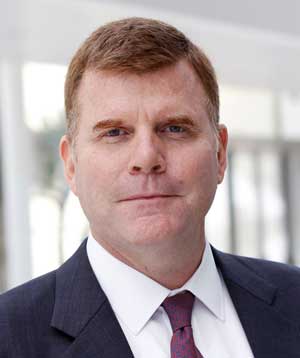On the heels of the launch of the Asian Development Bank’s latest Asian Development Outlook 2014 report, ADB Vice President Stephen P. Groff visited Asia Foundation headquarters in San Francisco last week to discuss key findings and how the ADB is realigning its operations to emphasize inclusiveness and strengthen support for middle-income countries. In Asia editor Alma Freeman sat down with Groff for more.
The ADB projects that developing Asia will achieve rising GDP growth of 6.2 percent in 2014, and 6.4 percent in 2015. While this growth is promising, you also warn of ongoing challenges facing Asia’s middle-income countries.
The ADB has talked a lot about the middle-income trap as a real issue for Asia. In fact, the issues surrounding inequality, lack of investment in education and social protection, governance, and institution-building are all part of the challenges we are seeing in middle-income countries in Asia and across the world. This is a particular issue for us because by 2020, at current development rates, we will have just two low-income country members – Afghanistan and Nepal. All of the other countries are projected to graduate into middle-income status by 2020. In addition, 90 percent of Asia’s extreme poor live in these middle-income countries. Other major issues such as environmental sustainability, resilience to climate change, and disaster risk reduction and mitigation have huge effects on the poor. But as we saw with Typhoon Yolanda, these shocks can cause people who are just above the poverty line to quickly drop below the line.
You mentioned that the factors that have driven Asia’s growth in the last decades are the factors that have also exacerbated inequality. How so?
Globalization, technological advances, and market reforms have been significant factors that have contributed to growth in the region. But it’s true that these are also things that have contributed to inequality. For example, access to technology and information is not equal across Asia, which in turn limits job opportunities for those people who lack such access. We don’t in any way suggest that technology or globalization should be limited, but rather that when you make policy changes, you have to be aware of the impact on the poor, and make sure that social protection policies are in place that will help them manage these types of transitions.
What does the middle-income trap mean for citizens of those countries?
The average citizen doesn’t know whether they are in the middle-income trap. But the average citizen does know what kind of job and education opportunities there are in their economy, and whether there is access to healthcare. This means that if you are above the poverty line, what are the things that are in place that keep you from falling below the poverty line? Those countries that have more safety nets in place that can support families when they have a shock, are those countries that are going to be better positioned to escape the middle-income trap.
How do these issues relate to the political and social unrest unfolding across the region?
At ADB, we think that income inequality and lack of access to opportunity is almost inevitably going to contribute to social instability, no matter what the country is. That is why we are focused on addressing the issue of inequality, not only because we have a mandate to reduce poverty in Asia, but also because economic stability and sustainable growth is going to require social stability, which in turn is going to require equal access and opportunity in income. Many countries recognize this, and are thinking about the types of policy reforms that are necessary to address this, but you see differences in how quickly some countries are acting on this or not.
China recently announced a plan to move 250 million rural residents into cities. What are your thoughts on Asia’s rapid urbanization?
Urbanization is an inevitable phenomenon in the world, and of course in Asia. The developed world is urbanized, so it’s not reasonable to expect that the development for low and middle income Asia is going to be anything other than urbanization. Therefore, we have over the last 30 years increasingly focused on urban infrastructure, urban services, and environmental quality, as these are factors that will ensure that, as these economies urbanize, there will also be quality infrastructure, quality housing provision, and positive environmental quality. Alongside this urbanization, modernization in agriculture is essential as well, because you cannot simply provide opportunities only in urban areas, and have agriculture still operating at low productivity and output. As Asia migrates, we need to think about what’s left behind in the rural areas and focus equally on higher productivity and more efficient agriculture in these economies. This is a challenge and there are a lot of issues to overcome, but that’s an important part of the process.
Source: Asia Foundation









